Spatiotemporal Dynamics and Land Cover Drivers of Herbaceous Aboveground Biomass in the Yellow River Delta from 2001 to 2022
Abstract
Highlight
- By mining literature-derived data and incorporating LAI and LGS, the random forest model achieved high-accuracy AGB mapping (R2 = 0.74) in the Yellow River Delta (2001–2022).
- Herbaceous AGB showed an overall increase, primarily driven by cropland and wetland expansion, while grassland contributed little or even negatively.
- Incorporating ecological variables significantly improves large-scale biomass estimation in herbaceous ecosystems.
- The findings support wetland conservation and sustainable land use management in delta regions.
Abstract
1. Introduction
2. Materials
2.1. Study Area
2.2. Field Data
2.3. Remote Sensing Data
2.3.1. Reflectance Information and Vegetation Index
2.3.2. Land Cover Data
2.3.3. Other Auxiliary Data
3. Methods
3.1. Herbaceous Vegetation Extraction
3.2. Herbaceous AGB Estimation
3.3. Trend Analysis
3.4. Driving Forces Detection
4. Results
4.1. Accuracy Assessment of AGB Modeling
4.2. Spatial Distribution of AGB in the YRD
4.3. Interannual Variation in AGB
4.4. Effects of Land Cover Changes on AGB
5. Discussion
5.1. Uncertainty Analysis of Literature-Derived Data
5.2. Effectiveness of LAI and LGS in AGB Estimation
5.3. Drivers of AGB Variation in the YRD
6. Conclusions
Author Contributions
Funding
Data Availability Statement
Conflicts of Interest
References
- Tilman, D.; Wedin, D.; Knops, J. Productivity and Sustainability Influenced by Biodiversity in Grassland Ecosystems. Nature 1996, 379, 718–720. [Google Scholar] [CrossRef]
- Dai, X.; Yang, G.; Liu, D.; Wan, R. Vegetation Carbon Sequestration Mapping in Herbaceous Wetlands by Using a MODIS EVI Time-Series Data Set: A Case in Poyang Lake Wetland, China. Remote Sens. 2020, 12, 3000. [Google Scholar] [CrossRef]
- Chave, J.; Réjou-Méchain, M.; Búrquez, A.; Chidumayo, E.; Colgan, M.S.; Delitti, W.B.C.; Duque, A.; Eid, T.; Fearnside, P.M.; Goodman, R.C.; et al. Improved Allometric Models to Estimate the Aboveground Biomass of Tropical Trees. Glob. Change Biol. 2014, 20, 3177–3190. [Google Scholar] [CrossRef]
- Zhou, R.; Yang, C.; Li, E.; Cai, X.; Wang, X. Aboveground Biomass Estimation of Wetland Vegetation at the Species Level Using Unoccupied Aerial Vehicle RGB Imagery. Front. Plant Sci. 2023, 14, 1181887. [Google Scholar] [CrossRef]
- Yang, D.; Yang, Z.; Wen, Q.; Ma, L.; Guo, J.; Chen, A.; Zhang, M.; Xing, X.; Yuan, Y.; Lan, X.; et al. Dynamic Monitoring of Aboveground Biomass in Inner Mongolia Grasslands over the Past 23 Years Using GEE and Analysis of Its Driving Forces. J. Environ. Manag. 2024, 354, 120415. [Google Scholar] [CrossRef] [PubMed]
- Li, J.; Liang, T.; Chen, Q. Estimating Grassland Yields Using Remote Sensing and GIS Technologies in China. N. Z. J. Agric. Res. 1998, 41, 31–38. [Google Scholar] [CrossRef]
- Oliveira, R.A.; Näsi, R.; Korhonen, P.; Mustonen, A.; Niemeläinen, O.; Koivumäki, N.; Hakala, T.; Suomalainen, J.; Kaivosoja, J.; Honkavaara, E. High-precision estimation of grass quality and quantity using UAS-based VNIR and SWIR hyperspectral cameras and machine learning. Precis. Agric. 2024, 25, 186–220. [Google Scholar] [CrossRef]
- Boussetta, S.; Balsamo, G.; Beljaars, A.; Kral, T.; Jarlan, L. Impact of a Satellite-Derived Leaf Area Index Monthly Climatology in a Global Numerical Weather Prediction Model. Int. J. Remote Sens. 2013, 34, 3520–3542. [Google Scholar] [CrossRef]
- Fang, H.; Baret, F.; Plummer, S.; Schaepman-Strub, G. An Overview of Global Leaf Area Index (LAI): Methods, Products, Validation, and Applications. Rev. Geophys. 2019, 57, 739–799. [Google Scholar] [CrossRef]
- Yuan, W.; Meng, Y.; Li, Y.; Ji, Z.; Kong, Q.; Gao, R.; Su, Z. Research on Rice Leaf Area Index Estimation Based on Fusion of Texture and Spectral Information. Comput. Electron. Agric. 2023, 211, 108016. [Google Scholar] [CrossRef]
- Tian, J.; Luo, X.; Xu, H.; Green, J.K.; Tang, H.; Wu, J.; Piao, S. Slower Changes in Vegetation Phenology than Precipitation Seasonality in the Dry Tropics. Glob. Change Biol. 2024, 30, e17134. [Google Scholar] [CrossRef]
- MacDougall, A.S.; Esch, E.; Chen, Q.; Carroll, O.; Bonner, C.; Ohlert, T.; Siewert, M.; Sulik, J.; Schweiger, A.K.; Borer, E.T.; et al. Widening Global Variability in Grassland Biomass since the 1980s. Nat. Ecol. Evol. 2024, 8, 1877–1888. [Google Scholar] [CrossRef]
- Morais, T.G.; Teixeira, R.F.M.; Figueiredo, M.; Domingos, T. The Use of Machine Learning Methods to Estimate Aboveground Biomass of Grasslands: A Review. Ecol. Indic. 2021, 130, 108081. [Google Scholar] [CrossRef]
- Li, H.; Liu, K.; Yang, B.; Wang, S.; Meng, Y.; Wang, D.; Liu, X.; Li, L.; Li, D.; Bo, Y.; et al. Continuous Monitoring of Grassland AGB during the Growing Season through Integrated Remote Sensing: A Hybrid Inversion Framework. Int. J. Digit. Earth 2024, 17, 2329817. [Google Scholar] [CrossRef]
- Wang, J.; Xiao, X.; Bajgain, R.; Starks, P.; Steiner, J.; Doughty, R.B.; Chang, Q. Estimating Leaf Area Index and Aboveground Biomass of Grazing Pastures Using Sentinel-1, Sentinel-2 and Landsat Images. ISPRS J. Photogramm. Remote Sens. 2019, 154, 189–201. [Google Scholar] [CrossRef]
- Wang, S.; Tuya, H.; Zhang, S.; Zhao, X.; Liu, Z.; Li, R.; Lin, X. Random Forest Method for Analysis of Remote Sensing Inversion of Aboveground Biomass and Grazing Intensity of Grasslands in Inner Mongolia, China. Int. J. Remote Sens. 2023, 44, 2867–2884. [Google Scholar] [CrossRef]
- Zeng, C.; Wu, J.; Zhang, X. Effects of Grazing on Above- vs. Below-Ground Biomass Allocation of Alpine Grasslands on the Northern Tibetan Plateau. PLoS ONE 2015, 10, e0135173. [Google Scholar] [CrossRef]
- Gao, X.; Dong, S.; Li, S.; Xu, Y.; Liu, S.; Zhao, H.; Yeomans, J.; Li, Y.; Shen, H.; Wu, S.; et al. Using the Random Forest Model and Validated MODIS with the Field Spectrometer Measurement Promote the Accuracy of Estimating Aboveground Biomass and Coverage of Alpine Grasslands on the Qinghai-Tibetan Plateau. Ecol. Indic. 2020, 112, 106114. [Google Scholar] [CrossRef]
- Breiman, L. Random Forests. Mach. Learn. 2001, 45, 5–32. [Google Scholar] [CrossRef]
- Li, H.; Li, F.; Xiao, J.; Chen, J.; Lin, K.; Bao, G.; Liu, A.; Wei, G. A Machine Learning Scheme for Estimating Fine-Resolution Grassland Aboveground Biomass over China with Sentinel-1/2 Satellite Images. Remote Sens. Environ. 2024, 311, 114317. [Google Scholar] [CrossRef]
- Wu, J.; Li, Y.; Li, N.; Shi, P. Development of an Asset Value Map for Disaster Risk Assessment in China by Spatial Disaggregation Using Ancillary Remote Sensing Data. Risk Anal. 2018, 38, 17–30. [Google Scholar] [CrossRef] [PubMed]
- Zhang, C.; Zhao, L.; Zhang, H.; Chen, M.; Fang, R.; Yao, Y.; Zhang, Q.; Wang, Q. Spatial-Temporal Characteristics of Carbon Emissions from Land Use Change in Yellow River Delta Region, China. Ecol. Indic. 2022, 136, 108623. [Google Scholar] [CrossRef]
- Hall Cushman, J.; Waller, J.C.; Hoak, D.R. Shrubs as Ecosystem Engineers in a Coastal Dune: Influences on Plant Populations, Communities and Ecosystems: Shrubs as Mediators of a Coastal Dune. J. Veg. Sci. 2010, 21, 821–831. [Google Scholar] [CrossRef]
- Ma, W.; Fang, J.; Yang, Y.; Mohammat, A. Biomass Carbon Stocks and Their Changes in Northern China’s Grasslands during 1982–2006. Sci. China Life Sci. 2010, 53, 841–850. [Google Scholar] [CrossRef]
- Fu, W.; Huang, M.; Horton, R. Soil Carbon Dioxide (CO2) Efflux of Two Shrubs in Response to Plant Density in the Northern Loess Plateau of China. Afr. J. Biotechnol. 2010, 9, 6916–6926. [Google Scholar]
- Li, D.; Ning, Z.; Chen, G.; Li, Y.N.; Cui, B.; Wang, Q.; Xie, T. The Effect of Land Use and Land Cover on Soil Carbon Storage in the Yellow River Delta, China: Implications for Wetland Restoration and Adaptive Management. J. Environ. Manag. 2024, 367, 122097. [Google Scholar] [CrossRef]
- Zhang, X.; Wang, G.; Xue, B.; Zhang, M.; Tan, Z. Dynamic Landscapes and the Driving Forces in the Yellow River Delta Wetland Region in the Past Four Decades. Sci. Total Environ. 2021, 787, 147644. [Google Scholar] [CrossRef]
- Xu, Z.; Li, R.; Dou, W.; Wen, H.; Yu, S.; Wang, P.; Ning, L.; Duan, J.; Wang, J. Plant Diversity Response to Environmental Factors in Yellow River Delta, China. Land 2024, 13, 264. [Google Scholar] [CrossRef]
- Xu, T.; Wang, F.; Shi, Z.; Xie, L.; Yao, X. Dynamic Estimation of Rice Aboveground Biomass Based on Spectral and Spatial Information Extracted from Hyperspectral Remote Sensing Images at Different Combinations of Growth Stages. ISPRS J. Photogramm. Remote Sens. 2023, 202, 169–183. [Google Scholar] [CrossRef]
- Anselin, L. Local Indicators of Spatial Association—LISA. Geogr. Anal. 1995, 27, 93–115. [Google Scholar] [CrossRef]
- Chander, G.; Markham, B.L.; Helder, D.L. Summary of Current Radiometric Calibration Coefficients for Landsat MSS, TM, ETM+, and EO-1 ALI Sensors. Remote Sens. Environ. 2009, 113, 893–903. [Google Scholar] [CrossRef]
- Vermote, E.F.; Tanre, D.; Deuze, J.L.; Herman, M.; Morcette, J.-J. Second Simulation of the Satellite Signal in the Solar Spectrum, 6S: An Overview. IEEE Trans. Geosci. Remote Sens. 1997, 35, 675–686. [Google Scholar] [CrossRef]
- Masek, J.G.; Vermote, E.F.; Saleous, N.E.; Wolfe, R.; Hall, F.G.; Huemmrich, K.F.; Gao, F.; Kutler, J.; Lim, T.-K. A Landsat Surface Reflectance Dataset for North America, 1990–2000. IEEE Geosci. Remote Sens. Lett. 2006, 3, 68–72. [Google Scholar] [CrossRef]
- Skakun, S.; Vermote, E.F.; Roger, J.-C.; Justice, C.O.; Masek, J.G. Validation of the LaSRC Cloud Detection Algorithm for Landsat 8 Images. IEEE J. Sel. Top. Appl. Earth Obs. Remote Sens. 2019, 12, 2439–2446. [Google Scholar] [CrossRef]
- Berk, A.; Conforti, P.; Kennett, R.; Perkins, T.; Hawes, F.; van den Bosch, J. MODTRAN® 6: A Major Upgrade of the MODTRAN® Radiative Transfer Code. In Proceedings of the 2014 6th Workshop on Hyperspectral Image and Signal Processing: Evolution in Remote Sensing (WHISPERS), Lausanne, Switzerland, 24–27 June 2014; pp. 1–4. [Google Scholar]
- Jordan, C.F. Derivation of Leaf-Area Index from Quality of Light on the Forest Floor. Ecology 1969, 50, 663–666. [Google Scholar] [CrossRef]
- Huete, A.R.; Didan, K.; Shimabukuro, Y.E.; Ratana, P.; Saleska, S.R.; Hutyra, L.R.; Yang, W.; Nemani, R.R.; Myneni, R. Amazon Rainforests Green-up with Sunlight in Dry Season. Geophys. Res. Lett. 2006, 33, 2005GL025583. [Google Scholar] [CrossRef]
- Jiang, Z.; Huete, A.; Didan, K.; Miura, T. Development of a Two-Band Enhanced Vegetation Index without a Blue Band. Remote Sens. Environ. 2008, 112, 3833–3845. [Google Scholar] [CrossRef]
- Richardson, A.J. Distinguishing Vegetation from Soil Background Information. Photogramm. Eng. Remote Sens. 1977, 43, 1541–1552. [Google Scholar]
- Tucker, C.J. Red and Photographic Infrared Linear Combinations for Monitoring Vegetation. Remote Sens. Environ. 1979, 8, 127–150. [Google Scholar] [CrossRef]
- Wang, C.; Chen, J.; Wu, J.; Tang, Y.; Shi, P.; Black, T.A.; Zhu, K. A Snow-Free Vegetation Index for Improved Monitoring of Vegetation Spring Green-up Date in Deciduous Ecosystems. Remote Sens. Environ. 2017, 196, 1–12. [Google Scholar] [CrossRef]
- Liu, H.Q.; Huete, A. A Feedback Based Modification of the NDVI to Minimize Canopy Background and Atmospheric Noise. IEEE Trans. Geosci. Remote Sens. 1995, 33, 457–465. [Google Scholar] [CrossRef]
- Rondeaux, G.; Steven, M.; Baret, F. Optimization of Soil-Adjusted Vegetation Indices. Remote Sens. Environ. 1996, 55, 95–107. [Google Scholar] [CrossRef]
- Zhang, X.; Liu, L.; Chen, X.; Gao, Y.; Xie, S.; Mi, J. GLC_FCS30: Global Land-Cover Product with Fine Classification System at 30 m Using Time-Series Landsat Imagery. Earth Syst. Sci. Data 2021, 13, 2753–2776. [Google Scholar] [CrossRef]
- Ali, I.; Cawkwell, F.; Dwyer, E.; Green, S. Modeling Managed Grassland Biomass Estimation by Using Multitemporal Remote Sensing Data—A Machine Learning Approach. IEEE J. Sel. Top. Appl. Earth Obs. Remote Sens. 2016, 10, 3254–3264. [Google Scholar] [CrossRef]
- Clevers, J.G.P.W.; van der Heijden, G.W.A.M.; Verzakov, S.; Schaepman, M.E. Estimating Grassland Biomass Using SVM Band Shaving of Hyperspectral Data. Photogramm. Eng. Remote Sens. 2007, 73, 1141–1148. [Google Scholar] [CrossRef]
- Kukreja, S.L.; Löfberg, J.; Brenner, M.J. A Least Absolute Shrinkage and Selection Operator (LASSO) for Nonlinear System Identification. IFAC Proc. Vol. 2006, 39, 814–819. [Google Scholar] [CrossRef]
- Fensholt, R.; Rasmussen, K.; Nielsen, T.T.; Mbow, C. Evaluation of Earth Observation Based Long Term Vegetation Trends—Intercomparing NDVI Time Series Trend Analysis Consistency of Sahel from AVHRR GIMMS, Terra MODIS and SPOT VGT Data. Remote Sens. Environ. 2009, 113, 1886–1898. [Google Scholar] [CrossRef]
- Yue, S.; Wang, C. The Mann-Kendall Test Modified by Effective Sample Size to Detect Trend in Serially Correlated Hydrological Series. Water Resour. Manag. 2004, 18, 201–218. [Google Scholar] [CrossRef]
- Su, B.; Ang, B.W. Structural Decomposition Analysis Applied to Energy and Emissions: Some Methodological Developments. Energy Econ. 2012, 34, 177–188. [Google Scholar] [CrossRef]
- McCree, K.J. The Action Spectrum, Absorptance and Quantum Yield of Photosynthesis in Crop Plants. Agric. Meteorol. 1971, 9, 191–216. [Google Scholar] [CrossRef]
- Wang, L.A.; Zhou, X.; Zhu, X.; Dong, Z.; Guo, W. Estimation of Biomass in Wheat Using Random Forest Regression Algorithm and Remote Sensing Data. Crop J. 2016, 4, 212–219. [Google Scholar] [CrossRef]
- Gough, L.; Moore, J.C.; Shaver, G.R.; Simpson, R.T.; Johnson, D.R. Above- and Belowground Responses of Arctic Tundra Ecosystems to Altered Soil Nutrients and Mammalian Herbivory. Ecology 2012, 93, 1683–1694. [Google Scholar] [CrossRef]
- Rigueiro-Rodríguez, A.; Mouhbi, R.; Santiago-Freijanes, J.J.; González-Hernández, M.D.P.; Mosquera-Losada, M.R. Horse Grazing Systems: Understory Biomass and Plant Biodiversity of a Pinus Radiata Stand. Sci. Agric. 2012, 69, 38–46. [Google Scholar] [CrossRef]
- Dusseux, P.; Hubert-Moy, L.; Corpetti, T.; Vertès, F. Evaluation of SPOT Imagery for the Estimation of Grassland Biomass. Int. J. Appl. Earth Obs. Geoinf. 2015, 38, 72–77. [Google Scholar] [CrossRef]
- Xie, J.; Wang, C.; Ma, D.; Chen, R.; Xie, Q.; Xu, B.; Zhao, W.; Yin, G. Generating Spatiotemporally Continuous Grassland Aboveground Biomass on the Tibetan Plateau Through PROSAIL Model Inversion on Google Earth Engine. IEEE Trans. Geosci. Remote Sens. 2022, 60, 1–10. [Google Scholar] [CrossRef]
- Li, P.; Zhu, W.; Xie, Z. Diverse and Divergent Influences of Phenology on Herbaceous Aboveground Biomass across the Tibetan Plateau Alpine Grasslands. Ecol. Indic. 2021, 121, 107036. [Google Scholar] [CrossRef]
- Zhu, C.; Li, Y.; Ding, J.; Rao, J.; Xiang, Y.; Ge, X.; Wang, J.; Wang, J.; Chen, X.; Zhang, Z. Spatiotemporal Analysis of AGB and BGB in China: Responses to Climate Change under SSP Scenarios. Geosci. Front. 2025, 16, 102038. [Google Scholar] [CrossRef]
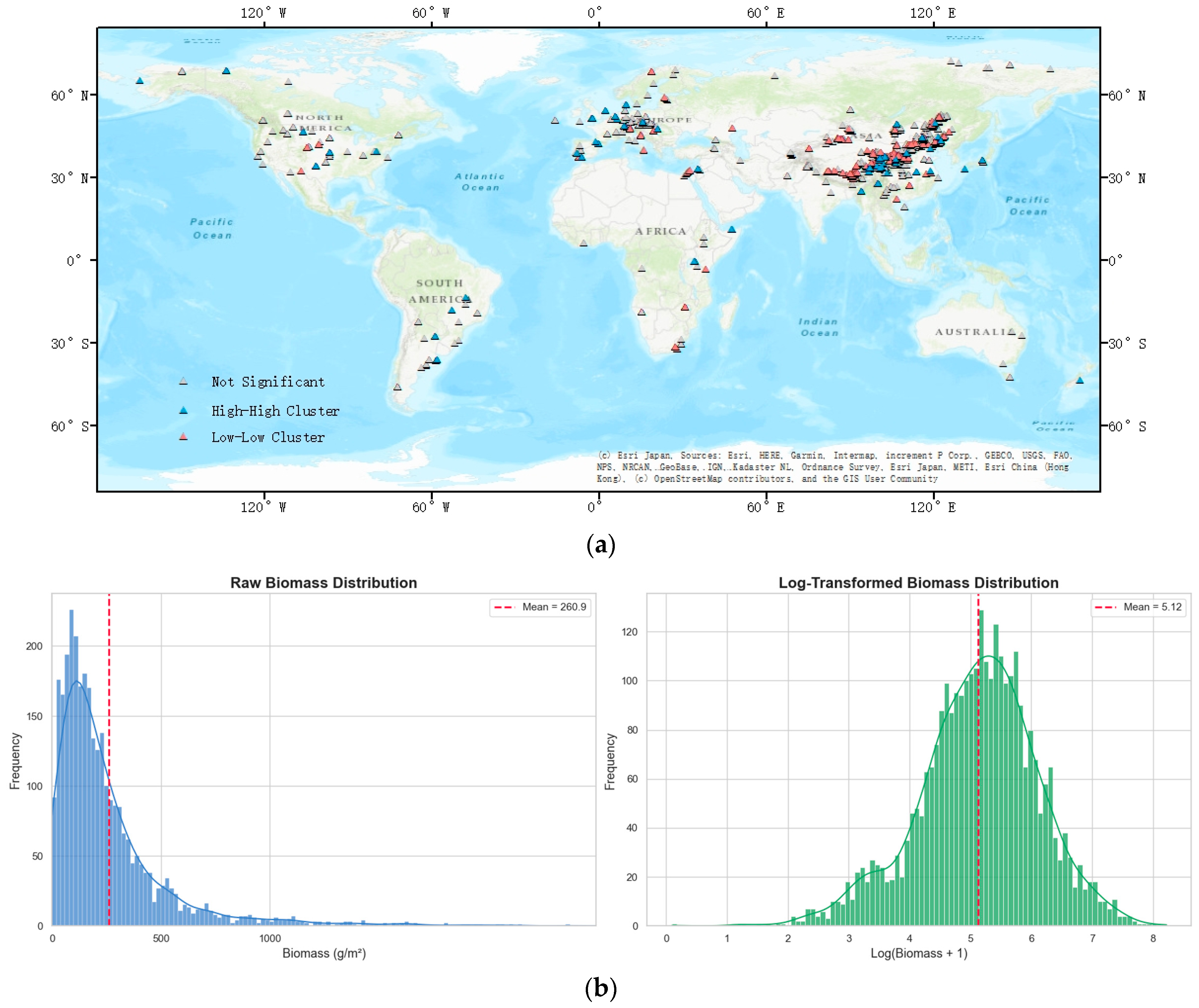

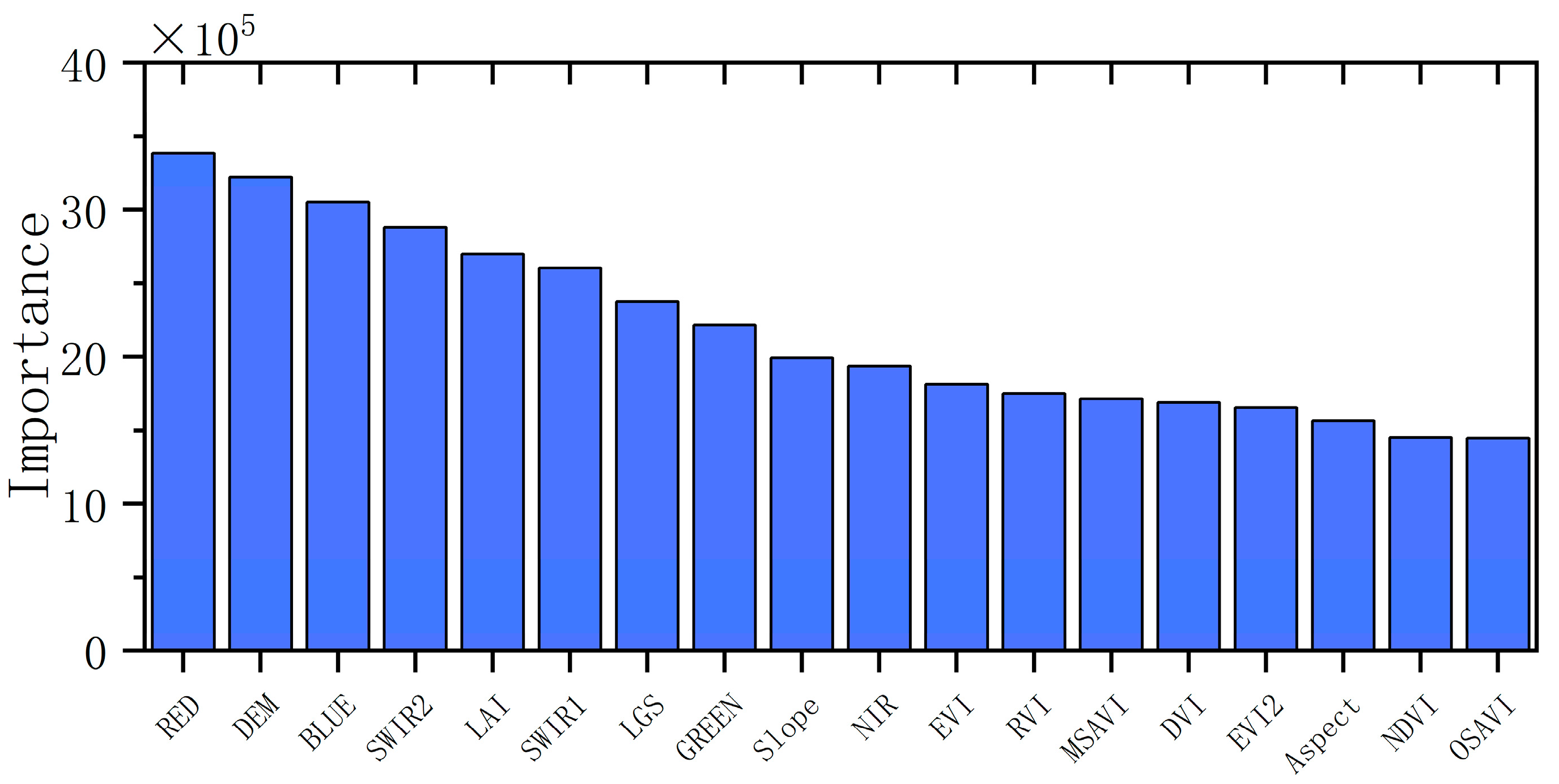



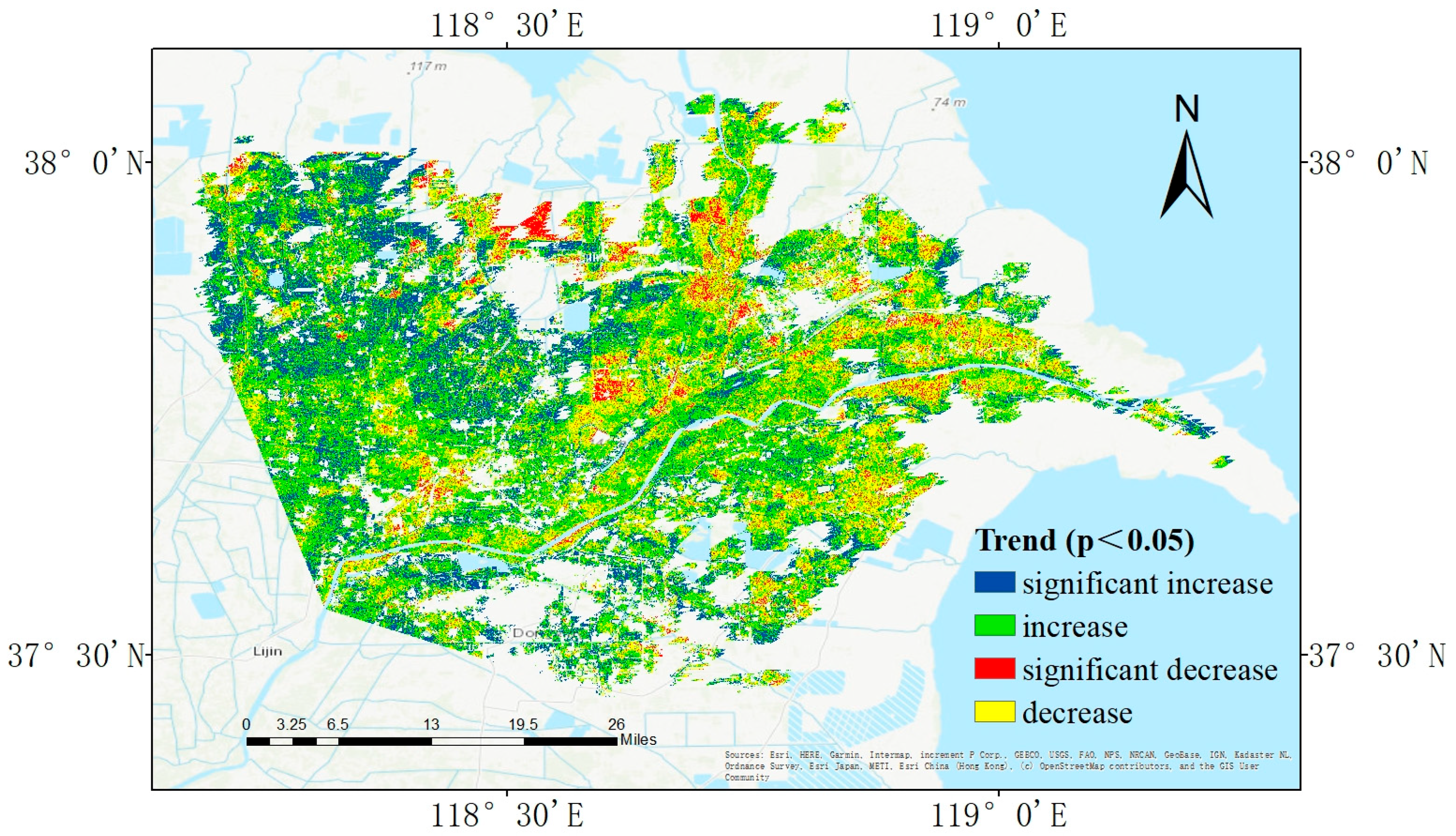
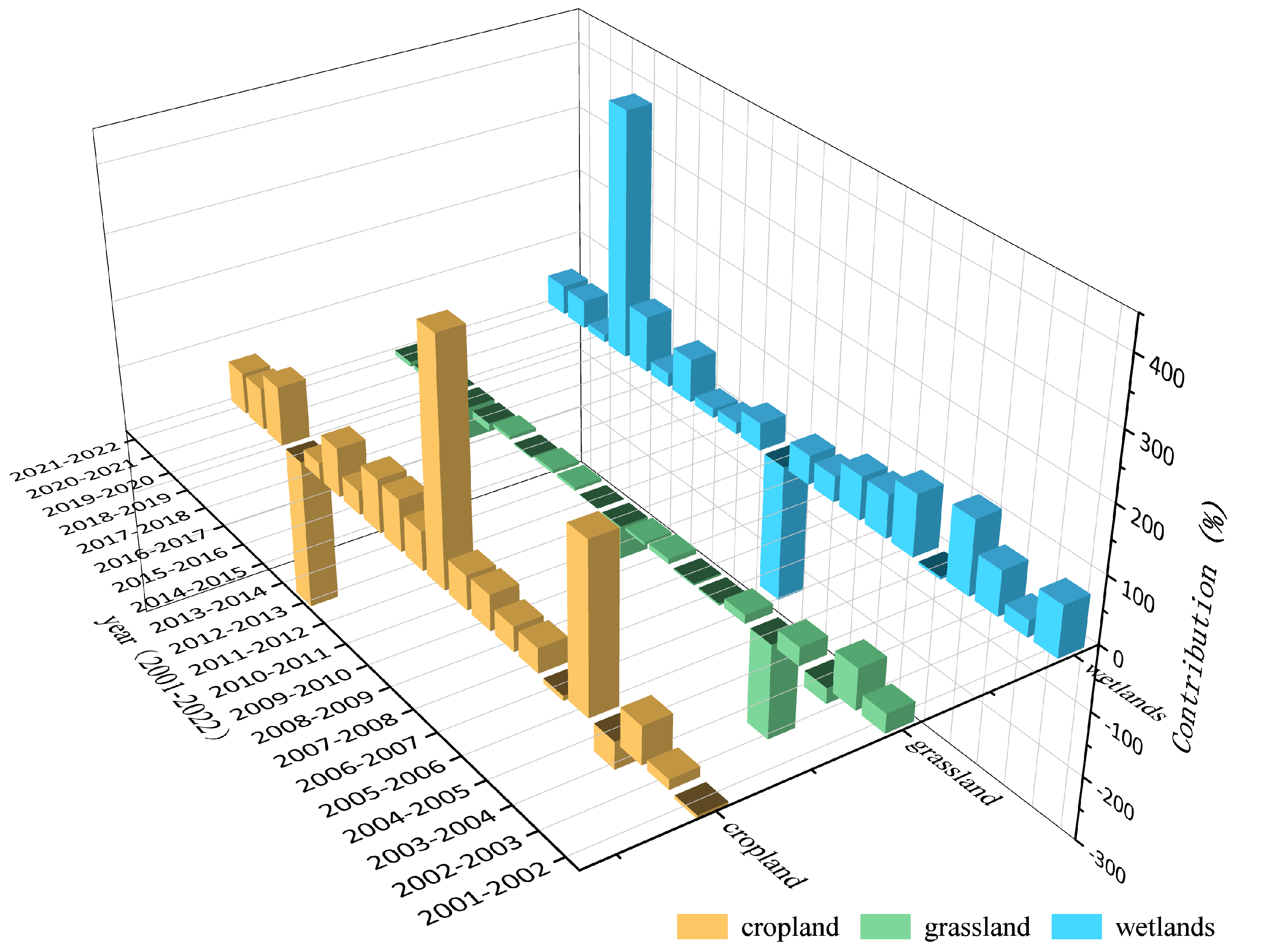

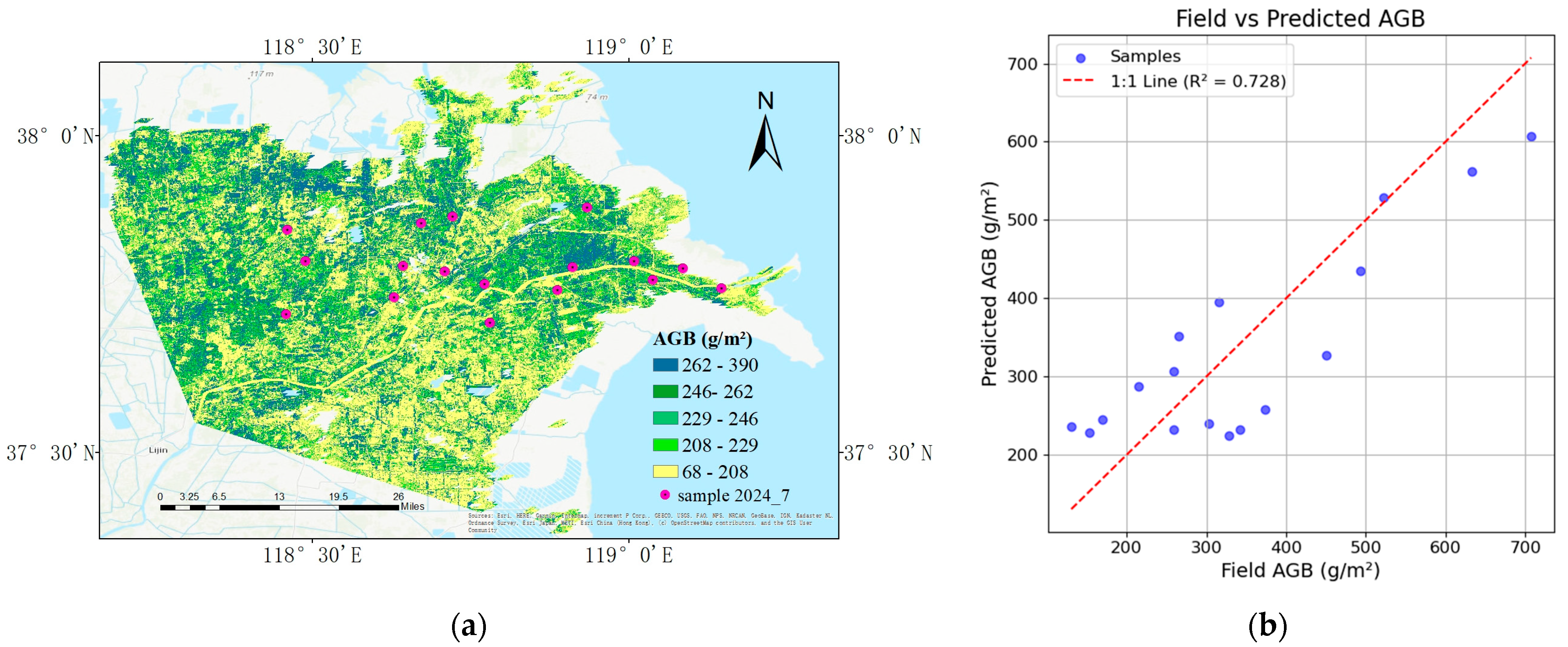


| VIs | Formula | Reference |
|---|---|---|
| RVI | [36] | |
| EVI | [37] | |
| EVI2 | [38] | |
| DVI | [39] | |
| NDVI | [40] | |
| NDPI | [41] | |
| MSAVI | [42] | |
| OSAVI | [43] |
| Reclassified Land Cover | GLC-FCS30 |
|---|---|
| Cropland | Herbaceous cover cropland, |
| Rainfed cropland, | |
| Irrigated cropland; | |
| Grassland | Grassland, |
| Lichens and mosses, | |
| Sparse herbaceous (fc < 0.15); | |
| Wetland | Swamp, |
| Marsh, | |
| Flooded flat, | |
| Salt marsh, | |
| Tidal flat; |
| Feature Categories | Variables |
|---|---|
| spectral variables | BLUE, GREEN, RED, NIR, SWIR1, SWIR2; |
| vegetation indices | NDVI, EVI, EVI2, RVI, DVI, OSAVI, MSAVI; |
| topographic variables | Elevation, Slope, Aspect; |
| ecological variables | LAI, LGS; |
| Feature Selection | Features |
|---|---|
| Selected by LASSO | NIR, SWIR1, Slope, Aspect, LGS, BULE, LAI, Elevation, SWIR2, GREEN, RED, DVI; |
| Not Selected | EVI, EVI2, OSAVI, MSAVI, NDVI, RVI; |
| Model | R2 (Testing Sets) | RMSE (g/m2) | Precision (%) |
|---|---|---|---|
| RF | 0.74 | 77.13 | 88.07% |
| LASSO-RF | 0.71 | 98.79 | 88.19% |
| SVM | 0.67 | 137.33 | 80.63% |
| LASSO-SVM | 0.69 | 121.76 | 80.30% |
| ANN | 0.55 | 224.75 | 85.96% |
| LASSO-ANN | 0.51 | 260.01 | 86.49% |
Disclaimer/Publisher’s Note: The statements, opinions and data contained in all publications are solely those of the individual author(s) and contributor(s) and not of MDPI and/or the editor(s). MDPI and/or the editor(s) disclaim responsibility for any injury to people or property resulting from any ideas, methods, instructions or products referred to in the content. |
© 2025 by the authors. Licensee MDPI, Basel, Switzerland. This article is an open access article distributed under the terms and conditions of the Creative Commons Attribution (CC BY) license (https://creativecommons.org/licenses/by/4.0/).
Share and Cite
Zhang, S.; Song, W.; Huang, N.; Tang, F.; Zhang, Y.; Liu, C.; Liu, Y.; Wang, L. Spatiotemporal Dynamics and Land Cover Drivers of Herbaceous Aboveground Biomass in the Yellow River Delta from 2001 to 2022. Remote Sens. 2025, 17, 3418. https://doi.org/10.3390/rs17203418
Zhang S, Song W, Huang N, Tang F, Zhang Y, Liu C, Liu Y, Wang L. Spatiotemporal Dynamics and Land Cover Drivers of Herbaceous Aboveground Biomass in the Yellow River Delta from 2001 to 2022. Remote Sensing. 2025; 17(20):3418. https://doi.org/10.3390/rs17203418
Chicago/Turabian StyleZhang, Shuo, Wanjuan Song, Ni Huang, Feng Tang, Yuelin Zhang, Chang Liu, Yibo Liu, and Li Wang. 2025. "Spatiotemporal Dynamics and Land Cover Drivers of Herbaceous Aboveground Biomass in the Yellow River Delta from 2001 to 2022" Remote Sensing 17, no. 20: 3418. https://doi.org/10.3390/rs17203418
APA StyleZhang, S., Song, W., Huang, N., Tang, F., Zhang, Y., Liu, C., Liu, Y., & Wang, L. (2025). Spatiotemporal Dynamics and Land Cover Drivers of Herbaceous Aboveground Biomass in the Yellow River Delta from 2001 to 2022. Remote Sensing, 17(20), 3418. https://doi.org/10.3390/rs17203418






